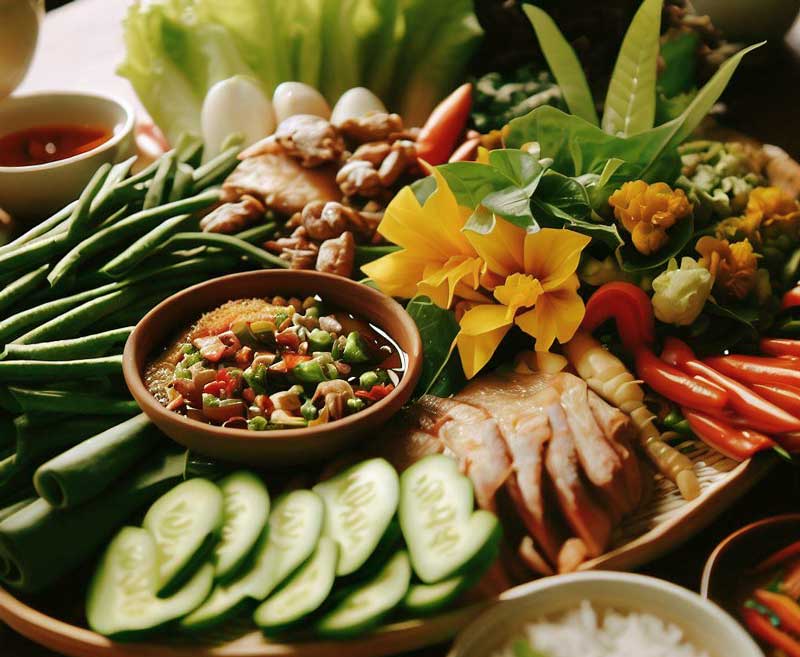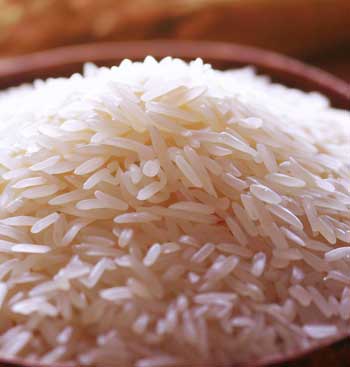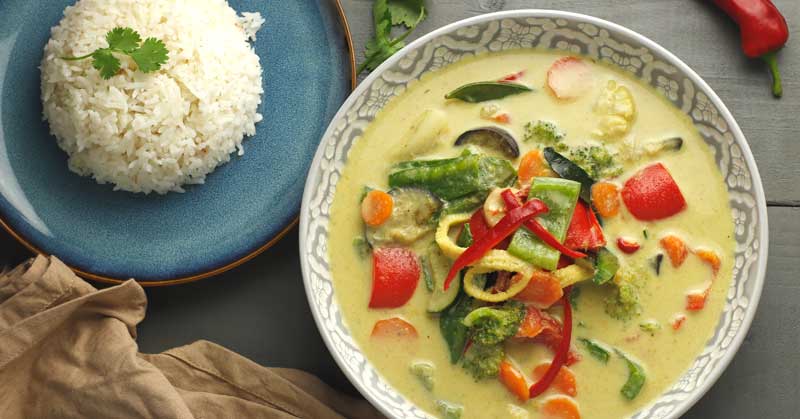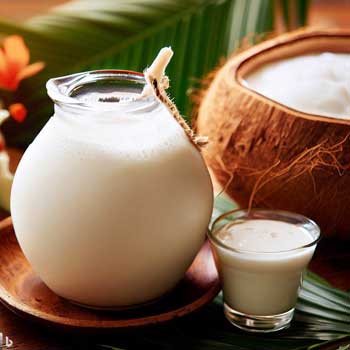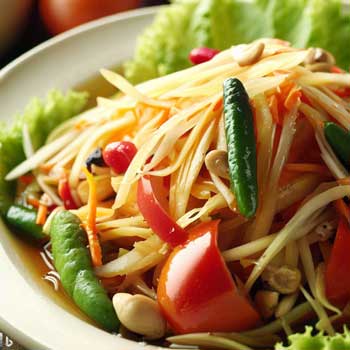Exactly How Healthy is Thai Food?
Thai cuisine is renowned for its vibrant flavors and aromatic spices. It’s easy to understand why it has gained a global fanbase. But amidst the mouthwatering dishes and savory aromas, a common question arises: Is Thai food healthy?
Let’s embark on a culinary journey to decipher the nutritional landscape of this beloved cuisine and uncover the truth behind the health benefits of Thai food.
The Heart of Thai Cuisine: Jasmine Rice
Rice holds a special place in the culinary heart of Thailand, where it is not merely a food staple but a cultural emblem that ties communities together. Embedded in the daily rhythm of Thai life, rice is savored throughout the day in various forms, reaffirming its significance.
You can’t ask the queston ‘is Thai food healthy’ without looking at rice. Thais eat Jasmine rice every day with just about everything so it’s probably a good start to see whether or not Thai Jasmine Rice is healthy or not.
Jasmine rice is a type of long-grain rice that is highly regarded for its characteristic fragrance. In terms of its nutritional composition, jasmine rice primarily consists of carbohydrates, with minimal amounts of protein and fat. It is also naturally gluten-free, making it suitable for individuals with gluten sensitivities.
Carbohydrates are the predominant macronutrient in jasmine rice. While some individuals might be concerned about the carbohydrate content, it’s important to recognize that carbohydrates are an essential energy source for the body. They provide fuel for various bodily functions, including brain function and physical activities.
One aspect that sets jasmine rice apart is its lower fiber content compared to other rice varieties like brown rice. Fiber is important for digestive health and can help regulate blood sugar levels.
While jasmine rice may be lower in fiber, it can still be included in a balanced diet when complemented with other fiber-rich foods.
The glycemic index (GI) measures how quickly a carbohydrate-containing food raises blood sugar levels. Jasmine rice has a higher GI compared to brown rice, meaning it can cause a more rapid spike in blood sugar. However, pairing jasmine rice with protein, healthy fats, and fiber-rich vegetables can help mitigate its impact on blood sugar levels.
In short, Thai jasmine rice is a carbohydrate-rich staple in Thai cuisine. While lower in fiber and higher in glycemic index compared to some rice types, it relatively healthy when consumed in moderation.
Concise Overview of Thai Jasmine Rice:
| Attribute | Description |
|---|---|
| Type | Long-grain rice |
| Aroma | Fragrant and distinctive |
| Macronutrients | Mainly carbohydrates with minimal protein and fat |
| Fiber Content | Lower compared to other rice varieties |
| Glycemic Index | Higher, potentially causing faster blood sugar rise |
| Portion Control | Moderation recommended to manage calorie intake |
| Balanced Pairing | Complement with fiber-rich foods for balanced meal |
| Cultural Significance | Integral part of Thai cuisine and daily life |
Are Thai Curries Healthy?
While Thai curries aren’t actually that popular in Thailand, they are one of the most popular dishes in Thai restauarnts around the world. But when it comes to healthiness, are these curries a wise choice? Let’s delve into the nutritional aspects of Thai curries to see if they are actually healthy or unhealthy.
Thai cuisine boasts a spectrum of curries, each with its distinct personality. From the fiery intensity of green curry to the milder, herb-infused panang curry, the variations are as diverse as the colors of the rainbow. While flavors and ingredients vary, the nutritional considerations often follow a similar pattern.
The Role of Coconut Milk in Thai Food
One characteristic that ties many Thai curries together is the use of coconut milk. While this creamy ingredient adds lusciousness and depth to curries, it also contributes to their calorie and fat content. Moderation is key, as coconut milk is calorie-dense, and consuming it in excess might impact your overall calorie intake.
Vegetables Are Always Good!
Thai curries often feature an abundance of vegetables, adding not only vibrant colors but also essential nutrients. From bell peppers and carrots to bamboo shoots and eggplant, these vegetables contribute vitamins, minerals, and fiber that enhance the nutritional profile of the dish.
Possible Protein Choices
The protein source in Thai curries can range from tender chicken or succulent shrimp to nutrient-rich tofu. Lean proteins are often favored, balancing out the dish and offering muscle-nourishing benefits.
Spices and Health Benefits
The spices used in Thai curries, such as turmeric, ginger, and chili peppers, bring more than just flavor to the table. They may offer potential health benefits, from anti-inflammatory properties to aiding digestion. However, it’s important to remember that while spices can contribute positively to your diet, the overall nutritional impact depends on the dish as a whole.
Here’s a table summarizing the nutritional information and health aspects of a typical Thai Green Curry:
| Aspect | Description |
|---|---|
| Key Ingredients | Coconut milk, green chili, lemongrass, basil, vegetables, protein (chicken, shrimp, tofu) |
| Flavor Profile | Aromatic, herb-infused, moderately spicy |
| Nutritional Highlights | Rich in vitamins, minerals, and antioxidants from herbs and vegetables. Protein source varies based on protein choice. Coconut milk contributes to creaminess and fat content. |
| Health Benefits | Turmeric in curry paste may have anti-inflammatory properties. Herbs like basil and lemongrass may aid digestion and boost immunity. |
| Consideration for Moderation | Coconut milk adds calories and fat. Adjust portion sizes based on dietary goals. |
| Customization | Choose lean protein options for lower fat content. Adjust spice levels based on preference. Include ample vegetables for added nutrients. |
| Serving Suggestion | Pair with whole grains like brown rice for balanced meal. Include fiber-rich sides for a wholesome experience. |
Is Thai Food Good For You – My Top 5 Healthiest Thai Dishes
Thai food is so varied. If you avoid the dishes that are pact with sugar or deep fried then there are actually some really healthy choices. Here are my top 5 healthiest Thai dishes:
1. Som Tum (Green Papaya Salad)
Bursting with fresh vegetables and the tangy kick of lime and chilies, Som Tum is a low-calorie option that offers a refreshing crunch.
2. Tom Kha Gai (Coconut Chicken Soup)
This creamy and flavorful soup balances lean chicken with the richness of coconut milk and the benefits of herbs like galangal and kaffir lime leaves.
3. Yam Nua (Thai Beef Salad)
Lean strips of beef tossed with herbs, lime juice, and chilies create a protein-packed dish that’s both satisfying and invigorating.
4. Pla Nueng Manao (Steamed Fish with Lime)
This dish showcases the delicate flavors of fish, elevated by the zesty brightness of lime and the umami of fish sauce.
5. Pad Pak Boong (Stir-Fried Morning Glory)
Morning glory, a nutrient-rich green, takes center stage in this dish. Stir-fried with garlic and chili, it’s a wholesome and flavorful choice.
Top 10 Healthiest Thai Foods With Average Calorie Count:
| Thai Dish | Average Calorie Count |
|---|---|
| Som Tum (Green Papaya Salad) | 100-150 calories |
| Tom Kha Gai (Coconut Chicken Soup) | 300-400 calories |
| Yam Nua (Thai Beef Salad) | 250-350 calories |
| Pla Nueng Manao (Steamed Fish with Lime) | 200-300 calories |
| Pad Pak Boong (Stir-Fried Morning Glory) | 100-150 calories |
| Tom Yum Goong (Spicy Shrimp Soup) | 200-300 calories |
| Gaeng Jued (Clear Soup with Vegetables) | 100-150 calories |
| Larb Gai (Chicken Salad) | 250-350 calories |
| Pad Pak (Stir-Fried Vegetables) | 100-150 calories |
| Gang Keow Wan Gai (Green Curry with Chicken) | 300-400 calories |
Obesity in Thailand vs The West

One final thing to think about when asking the question ‘is Thai food healthy?’, is that Thais generally are not overweight. Even though the country has seen a rise in overweight and obese individuals, particularly among urban populations, it’s not down to Thai food.
A changing food environment with the introduction of western fast food is largely to blame. Even then, it’s important to recognize that Thailand’s obesity rates remain lower than many Western nations.
Overall Thai food would be considered healthier than many western foods. Portion size and the exact type of food does have an impact though. After all, every country’s cuisine has unhealthy foods.

